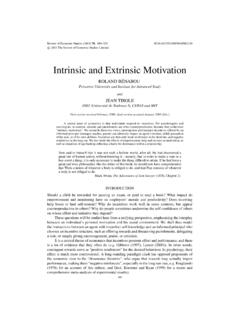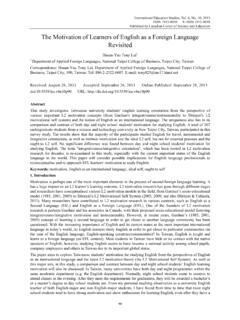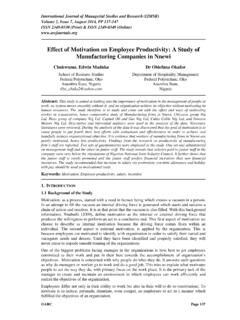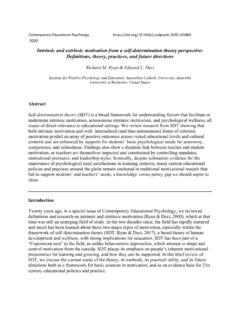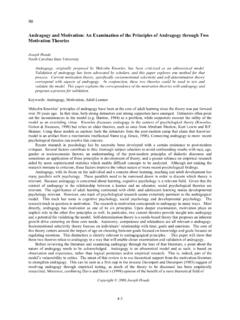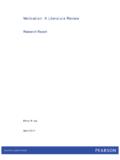Transcription of Motivation - Purdue
1 1 1 Motivation Chapter 11 2 What Motivates You To Come To Class? 3 Motivation Motivation is a need or desire that energizes behavior and directs it towards a goal. What s the difference between a need and a desire? Extrinsic Motivation is something outside the person that energizes behavior. Money, fame, power Intrinsic Motivation is something within the person that energizes behavior. Interest, curiosity, personal challenge and improvement 4 Do Rats Have a Protestant Work Ethic? The earned vs.
2 Free food phenomenon 5 Perspectives on Motivation Perspectives to explain Motivation include the following: Instinct Theory Drive-Reduction Theory Arousal Theory Hierarchy of Motives Cognitive based theory: Self-efficacy 6 Instincts & Evolutionary Psychology Instincts are complex behaviors that have fixed patterns throughout different species and are not learned (Tinbergen, 1951). Where the woman builds different kinds of houses the bird builds only one kind of nest. Ariel Skelley/ Masterfile Tony Brandenburg/ Bruce Coleman, Inc.
3 2 7 Drive-Reduction Theory When the instinct theory of Motivation failed to explain most human Motivation , it was replaced by the drive-reduction theory. A physiological need creates an aroused tension state (a drive) that motivates an organism to satisfy the need (Hull, 1951). 8 Drive Reduction Food Drive Reduction Organism The physiological aim of drive reduction is homeostasis, the maintenance of a steady internal state ( , maintenance of steady body temperature). Stomach Full Empty Stomach (Food Deprived) 9 Incentive Where our needs push, incentives (positive or negative stimuli) pull us in reducing our drives.
4 Henry Murray called these needs and presses. A food-deprived person (n Hunger) who smells baking bread (incentive) (p Food) feels a strong hunger drive. 10 Question What need would explain why we seek thrills, excitement? Why do we like scary movies? What drives are being reduced by going on a roller coaster or parachuting? 11 Optimum Arousal Human Motivation aims to seek optimum levels of arousal, not to eliminate it. Young monkeys and children are known to explore the environment in the absence of a need-based drive.
5 Harlow Primate Laboratory, University of Wisconsin Randy Faris/ Corbis 12 Hierarchy of Needs Abraham Maslow (1970) suggested that certain needs have priority over others. Physiological needs like breathing, thirst, and hunger come before psychological needs such as achievement, self-esteem, and the need for recognition. (1908-1970) 3 13 Maslow s Hierarchy of Needs Hurricane Survivors Menahem Kahana/ AFP/ Getty Images Mario Tama/ Getty Images David Portnoy/ Getty Images for Stern Joe Skipper/ Reuters/ Corbis 14 Self-Efficacy-Bandura A belief (cognitive component of theory) in one s abilities to succeed A sense of control over one s environment (social, work, etc.)
6 Self-efficacy can be strengthened with clear goals, social modeling, feedback, and challenges to current ability levels. On YouTube, there are many short videos about self-efficacy. 15 Classic Positions on Motivation Freud Id Ego Superego Skinner Reinforcement Humanistic (Maslow, Rogers) Self-actualization Specific Motivations Social Control Hunger Sex Belonging Work 16 17 Social Motivation Others opinions and evaluations of self contribute to a strong motivating system Social Facilitation, Social Loafing Self-monitoring Fame Being known, recognized may supersede being liked Jerry Springer s guests?
7 Conformity Fitting in = Being liked Avoiding rejection/exclusion Social Motivation contributes to what and how much we eat, whether or not we smoke, take drugs, have 18 Coactive or Evaluative Presence of Others likelihood of dominant response performance on easy, well-learned tasks performance on difficult, poorly learned tasks But, why? (1) Compresence (Zajonc, 1966) (2) Evaluation apprehension (Cottrell, 1968) (3) Distraction-conflict (Baron & Sanders, 1986) Arousal 4 19 20 Latan , Williams, & Harkins (1979) 21 Control Motivation Reactance When you feel that your freedom is being restricted, you will act in such a way to regain that freedom Learned Helplessness Upon repeated noncontingencies between one s behaviors and one s outcomes (and after initial reactance)
8 , learned helplessness occurs Uncontrolled negative outcomes more likely to cause LH than uncontrolled positive outcomes But see Self-handicapping Giving up Pessimism Depression Learned Helplessness Tutorial 22 Hunger When do we eat? Why do we like certain foods and not others? Why do we eat too much? Why do our emotions affect our eating? An obvious answer to When do we eat? is When are we hungry. Turns out, that s only part of the answer. But, how do we know when we are hungry?
9 When there is no food in our stomach. How do we know when our stomach is empty? Our stomach growls. These are also called hunger pangs. 23 The Physiology of Hunger Stomach contractions (pangs) send signals to the brain making us aware of our hunger. 24 Removed Tsang (1938) removed rat stomachs, connected the esophagus to the small intestines, and the rats still felt hungry (and ate food). In other words, no hunger pangs were eating persisted 5 25 The Importance of Glucose: C6H12O6 Increases in insulin (a hormone affecting pancreas, liver, muscle, and fat tissue) decreases glucose in the blood.
10 Decreased glucose makes us feel hungry. Glucose Molecule Insulin also affects brain: improves verbal memory 26 Glucose & the Brain Levels of glucose in the blood are monitored by receptors (neurons) in the stomach, liver, and intestines. They send signals to the hypothalamus in the brain. Rat Hypothalamus 27 Hypothalamic Centers The lateral hypothalamus (LH) brings on hunger (stimulation). Destroy the LH, and the animal has no interest in eating. With the LH intact, the reduction of blood glucose leads rats to eat ravenously.



